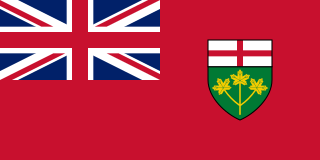Joseph-Ignace Aumond (March 21, 1810 – November 9, 1879) was a lumber merchant in Ontario, Canada. He was considered a prominent Canadian timber baron of his time. [1]

Ontario is one of the 13 provinces and territories of Canada and is located in east-central Canada. It is Canada's most populous province accounting for 38.3 percent of the country's population, and is the second-largest province in total area. Ontario is fourth-largest jurisdiction in total area when the territories of the Northwest Territories and Nunavut are included. It is home to the nation's capital city, Ottawa, and the nation's most populous city, Toronto, which is also Ontario's provincial capital.
The son of Ignace Aumon and Euphrosine Robichaud, he was born in L'Assomption, Lower Canada and went to work as a store clerk in Montreal after completing his schooling. He came to Bytown to operate a store for his employer and later opened his own general store there. Around 1830, Aumond began operating in the timber business in the Ottawa Valley. He held timber cutting rights along the Madawaska, Petawawa and Gatineau Rivers. During the late 1840s, Aumond built one of the largest steam-powered sawmills in Canada at the time. He later suffered a major financial setback but continued on in the timber trade at a reduced level. [1]

L'Assomption is an off-island suburb of Montreal, in southwestern Quebec, Canada on the L'Assomption River. It is the seat of the Regional County Municipality of L'Assomption. It is located on the outer fringes of the Montreal urban area.

The Province of Lower Canada was a British colony on the lower Saint Lawrence River and the shores of the Gulf of Saint Lawrence (1791–1841). It covered the southern portion of the current-day Province of Quebec, Canada, and the Labrador region of the modern-day Province of Newfoundland and Labrador.
Bytown is the former name of Ottawa, Ontario, Canada's capital city. It was founded on September 26, 1826, incorporated as a town on January 1, 1850, and superseded by the incorporation of the City of Ottawa on January 1, 1855. The founding was marked by a sod turning, and a letter from Governor General Dalhousie which authorized Lieutenant Colonel John By to divide up the town into lots. Bytown came about as a result of the construction of the Rideau Canal and grew largely due to the Ottawa River timber trade. Bytown's first mayor was John Scott, elected in 1847.
In 1833, Aumond married Jane Gumming. They had eight children. [1]
Aumond was president of the Bytown and Montreal Telegraph Company. He helped establish the Bytown and Prescott Railway [2] and served as one of its first directors. He was a partner with John Egan in the operation of two steamships on the Ottawa River and also partnered with Egan and Ruggles Wright in constructing a horse-drawn railway to provide an overland connection around rapids to link the two steamship routes. [1] He was also a director with Robert Conroy and Richard McConnell of the Bytown and Aylmer Union Turnpike Company [3] which completed the road linking Bytown and Aylmer in 1850; Egan was company president. [1]
The Bytown and Prescott Railway (B&PR) was a railway joining Ottawa with Prescott on the Saint Lawrence River. The company was incorporated in 1850, and the first train ran from Prescott into Bytown on Christmas Day, 1854. The 84 km railway, Ottawa's first to outside markets, was initially used to ship lumber collected on the Ottawa River for further shipping along the St. Lawrence to markets in the United States and Montreal.

John Egan was an Irish-Canadian businessman and political figure in the Ottawa region.

A steamship, often referred to as a steamer, is a type of steam powered vessel, typically ocean-faring and seaworthy, that is propelled by one or more steam engines that typically move (turn) propellers or paddlewheels. The first steamships came into practical usage during the early 1800s; however, there were exceptions that came before. Steamships usually use the prefix designations of "PS" for paddle steamer or "SS" for screw steamer. As paddle steamers became less common, "SS" is assumed by many to stand for "steam ship". Ships powered by internal combustion engines use a prefix such as "MV" for motor vessel, so it is not correct to use "SS" for most modern vessels.
He helped organize the first fire company in Bytown in 1838, also serving on the first school board and on the Board of Health for the town. He was also a prominent member of the Ottawa Association of Lumber Manufacturers. In 1874, he ran unsuccessfully as a Conservative for the Ottawa City seat in the House of Commons of Canada. Aumond served in the Carleton County militia, reaching the rank of colonel. [1]

The House of Commons of Canada is a component of the Parliament of Canada, along with the Sovereign and the Senate. The House of Commons currently meets in a temporary Commons chamber in the West Block of the parliament buildings on Parliament Hill in Ottawa, while the Centre Block, which houses the traditional Commons chamber, undergoes a ten-year renovation.
He died in Ottawa at the age of 69. [1]
The township of Aumond, Quebec was named in his honour. [4]

Aumond is a township municipality in the Canadian province of Quebec, located within La Vallée-de-la-Gatineau Regional County Municipality.





